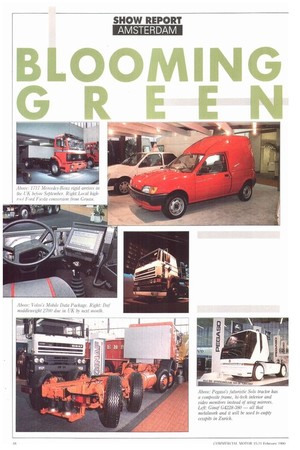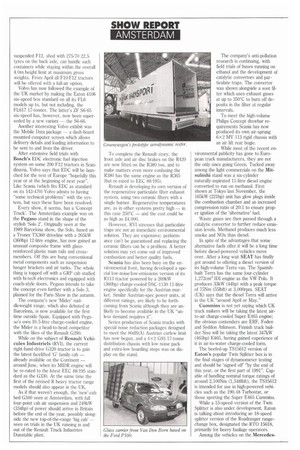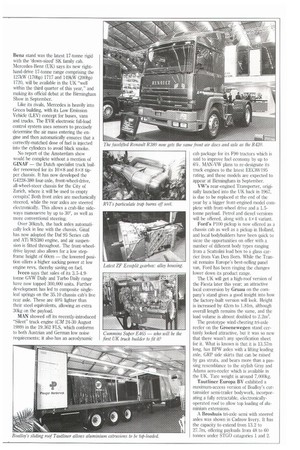bLOOMING
Page 50

Page 51

Page 52

Page 53

If you've noticed an error in this article please click here to report it so we can fix it.
R-E EN • Having witnessed the proliferation of environmentally-friendly trucks at the Frankfurt Show last September Commercial Motor described the future of road transport as 'Green'. If Frankfurt was the spring of the Green truck, then this week's Amsterdam Exhibition was close to becoming the blooming summer.
Visitors would have found it difficult to ignore the constant background murmurings of environmental buzzwords such as NOx, hydrocarbons, catalytic convertors, soot filters, partial encapsulation and the current favourite — gaseous emissions.
Behind the PR hype lies a much more serious matter. For while the truck manufacturers are striving to comply with regulations prompted by legislation from the likes of Switzerland, Sweden and Austria, few operators are likely to make any moves towards adopting Green machines until they have to.
Their attitude is likely to be one of: "Why should I spend extra money on environmental equipment, above that already fitted, when I don't have to?"
More civic-minded operators — particularly city bus operators — may prove to be the exception to this rule, but the average haulier can hardly be blamed for feeling that making trucks more environmentally acceptable is a problem for lhe manufacturer, After all, when it becomes law to fit such equipment, then hauliers will have to pay for it out of fragile profit margins. In any case, the one thing all hauliers can, and must do, is ensure that the impact of actually running a haulage company on the local environment is kept to an absolute minimum. But it may take a threat to their 0-Licences before sonic operators finally go Green.
Judging by the latest efforts of the truck makers on show in Amsterdam, the problem of the trucks, rather than the users, is being tackled now.
With Amsterdam being very much its own turf, it was only natural that Daf would make a show of it. To please the environmentalists it has developed nine engines, from 5.9 litres to 11.6 litres, which have a maximum NOx (nitrogen oxides) emission of 9g/kW/h, placing them well inside the requirements of the longstanding ECE R49 directive which covers gaseous emissions, but not particulates.
More significant, however, is that the "9 NOx" series Green engines will meet the tougher 88/77 EEC standard, again on gaseous emissions, and due to come into force on 1 October of this year for manufacturing, and on 1 April 1991 on truck registrations. Yet more regulations are in the melting pot, both from the EC and outside, which will include particulates (soot), but the final drafts have yet to be decided upon. Commercial Motor will be examining emission regulations in a forthcoming "Engineers Notebook".
Among the "9 NOx" engine family is the heavily-reworked 8.25-litre HS200
ATi engine in the latest Daf 2700 middleweight — revealed exclusively by CM last November. The 200kW (272hp) IS200 offers slightly more power and torque than the old 195kW (265hp) DI-IS engine used in the superseded 2500, with a 6% improvement on specific fuel consumption across a wider rev range. The new 2700, and 2300 powered by the 168kW (228hp) HT168 engine, should reach the UK next month. But we won't be getting the 29(X) and 3200 models with the wider, reworked old 2800 cab, not least as it would clash with the existing Roadtrain and 95.310 tractors.
As part of its middleweight product revival, the long-serving Daf cab has been facelifted outside and revised inside, but the biggest changes are under the cab. where the 8.25-litre Daf engine gains a new turbocharger, exhaust manifold, cylin Below: Sales of lveco Daily models are going strong. The 35.10 chassis cub now has composite springs on the back axle. der heads, camshaft, valves, injection pump, injectors, crankshaft, pistons and a higher compression ratio. New glowplugs in the air intake help reduce the amount of cold start fuel by a claimed 75%, keeping smoke emission to a minimum. Improved oil rings should also reduce oil consumption and thus emissions.
To go with the new middleweights, Daf has also introduced an alloy clutch housing and the latest alloy-cased ZF Ecosplit gearbox in nine or 16-speed form.
Other "9 NOx" power units include those in the 95.350 and 95.380, but as yet the Dutch manufacturer is being coy as to when it will launch the 298kW (400hp) plus version of its 11.6-litre WS engine, An NEC debut in September must, however, be one possibility.
Daf says that its 2300 and 2700 tractors and rigid trucks already meet proposed EC drive-by noise levels of 84dB(a), but that both should soon he available with noise reduction packages taking them down to 80dB(A), meeting the recentlyintroduced Austrian night-time limit.
Volvo has also been working on noise reduction to comply with the Austrian legislation. It has uprated the 84dB(A) insulation package on the F12 so it now meets the 80dB(A) limit. Now the package will be introduced on other models in the range. Volvo's City Filter particulate trap, seen at the Geneva show, was also at Amsterdam. Larger wheelbase tractors, to meet the revised 16.5m artic laws, were much in abundance on the Volvo stand, although by far the most interesting exhibit was an F12 tractor with all-round air suspension (a la Scania) but with a fifth wheel height down from 1.20m to 1.05m.
The extra low F12 is for use with 13.7m (45ft) containers found on the Continent which are 2.89m high. The suspended F12, shod with 275/70 22.5 tyres on the back axle, can handle such containers while staying within the overall 4.0m height limit at maximum gross weights. From April all F10/F12 tractors will be offered with a full-air option.
Volvo has now followed the example of the UK market by making the Eaton 4106 six-speed box standard on all its FL6 models up to, but not including, the FL617 17-tonner. The latter's ZE S6-65 six-speed has, however, now been superseded by a new variant — the 56-66.
Another interesting Volvo exhibit was the Mobile Data package — a dash-board mounted computer screen which allows delivery details and loading information to be sent to and from the driver.
After extensive field trials with Bosch's EDC electronic fuel injection system on some 200 F12 tractors in Scandinavia, Volvo says that EDC will be launched for the rest of Europe "hopefully this year or at the beginning of next year". Like Scania (which fits EDC as standard on its 143-470) Volvo admits to having "some technical problems" with the system, but says these have been resolved.
Every show, it seems, has a 'Concept Truck'. The Amsterdam example was on the Pegaso stand in the shape of the stylish 'Solo 2'. Originally seen at the 1989 Barcelona show, the Solo, based on a Troner TX360 driveline with a 265kW (360hp) 12-litre engine, has now gained an unusual composite frame with glassreinforced plastic main rails and crossmembers. Off this are hung conventional metal components such as suspension hanger brackets and air tanks. The whole thing is topped off with a GRP cab stuffed with hi-tech electronics and equipped with coach-style doors. Pegaso intends to take the concept even further with a Solo 3, planned for the Paris Show in the autumn.
The company's new 'Mider' middleweight range, which also debuted at Barcelona, is now available for the first time outside Spain. Equipped with Pegaso's own 10.5-litre charge-cooled engine, the Mider is a head-to-head competitor with the likes of the Renault G290.
While on the subject of Renault Vehicules IndustrieIs (RV1), the current right-hand-drive G320 tractor is to gain the latest facelifted 'G' family cab — already available on the Continent — around June, when its MIDR engine will be re-rated to the latest EEC 88/195 standard as the G330. At the same time the first of the revised R heavy tractor range models should also appear in the UK.
As if that weren't enough, the 'new'-cab bed G340 seen at Amsterdam, with full four-point cab air suspension and 249kW (334hp) of power should arrive in Britain before the end of the year, possibly alongside the new top-of-the-range 'big cab' — seen on trials in the UK running in and out of the Renault Truck Industries Dunstable plant. To complete the Renault story, the front axle and air disc brakes on the R420 are now fitted on the R380 too, and to make matters even more confusing the R380 has the same engine as the R365 (but re-rated to EEC 88/195).
Renault is developing its own version of the regenerative particulate filter exhaust system, using two ceramic filters with a single burner. Regenerative temperatures are, as in other systems pretty high — in this case 250°C — and the cost could be as high as £4,000.
However, RVI stresses that particulate traps are not an immediate environmental solution. They are expensive; performance can't be guaranteed and replacing the ceramic filters can be a problem. A better solution may yet come out of improved combustion and better quality fuels.
Scania has also been busy on the environmental front, having developed a special low-noise/low-emissions version of its R113 tractor powered by a 269kW (360hp) charge-cooled DSC-1130 11-litre engine specifically for the Austrian market. Similar Austrian-spec power units, at different ratings, are likely to be forthcoming from Scania although they are unlikely to become available in the UK "unless demand requires it".
Series production of Scania trucks with special noise reduction packages designed to meet the 80dB(A) Austrian curfew limit has now begun, and a 4x2 G93 17-tonne distribution chassis with low noise pack and extra-low boarding steps was on display on the stand. The company's anti-pollution research is continuing, with field trials of buses running on ethanol and the development of catalytic convertors and particulate traps. The convertor was shown alongside a soot filter which uses exhaust gases at up to 350°C to burn off deposits in the filter at regular intervals.
To meet the high-volume Philips Concept drawbar requirements Scania has now produced its own air-sprung 6x2 MV 113 rigid chassis with an air lift rear bogie.
While most of the recent environmental publicity has gone to European truck manufacturers, they are not the only ones going Green. Tucked away among the light commercials on the Mitsubishi stand was a six-cylinder naturally-aspirated 11-litre diesel engine converted to run on methanol. First shown at Tokyo last November, the 165kW (221hp) unit has glow plugs inside the combustion chamber and an increased compression ratio of 20:1 to ensure proper ignition of the `alternative' fuel.
Waste gases are then passed through a catalytic convertor to further reduce emission levels. Methanol produces much less smoke and NOx than diesel.
In spite of the advantages that some alternative fuels offer it will be a long time before diesel-powered vehicles move over. After a long wait SEAT has finally got around to offering a diesel version of its high-volume Terra van. The Spanishbuilt Terra has the same four-cylinder 1,272cm ID1 engine as the VW Polo. It produces 33kW (44hp) with a peak torque of 75Nm (55Ibft) at 3,000rpm. SEAT (UK) says that the diesel Terra will arrive in the UK "around April or May."
Cummins is not yet saying which UK truck makers will be taking the latest airto-air charge-cooled Super E465 engine; the obvious contenders are ERF, Foden and Seddon Atkinson. Finnish truck builder Sisu will be taking the latest 347kW (465hp) E465, having gained experience of it in air-to-water charge-cooled form.
The beefed-up TS15612 version of Eaton's popular Twin Splitter box is in the final stages of dynamometer testing and should be 'signed off' "by the end of this year, or the first part of 1991". Capable of handling nominal torque ratings of around 2,100Nm (1,548Ibft), the TS15612 is intended for use in high-powered vehicles such as the 190.48 Turbostar, or those sporting the Super E465 Cummins.
While a 15-speed version of the Twin Splitter is also under development, Eaton is talking about introducing an 18-speed splitter version of the Roadranger rangechange box, designated the RTO 15618, primarily for heavy haulage operators.
Among the vehicles on the Mercedes Benz stand was the latest 17-tonne rigid with the 'down-sized' SK family cab. Mercedes-Benz (UK) says its new righthand-drive 17-tonne range comprising the 127kW (170hp) 1717 and 149kW (200hp) 1720, will be available in the UK "well within the third quarter of this year," and making its official debut at the Birmingham Show in September.
Like its rivals, Mercedes is heavily into Green building, with its Low Emission Vehicle (LEV) concept for buses, vans and trucks. The EVR electronic full-load control system uses sensors to precisely determine the air mass entering the engine and then automatically ensures that a correctly-matched dose of fuel is injected into the cylinders to avoid black smoke.
No report of the Amsterdam show would be complete without a mention of G1NAF — the Dutch specialist truck builder renowned for its 10 x 8 and 8x8 tipper chassis. It has now developed the G4228-380 four-axle, front-wheel-drive, all-wheel-steer chassis for the City of Zurich, where it will be used to empty cesspits? Both front axles are mechanically steered, while the rear axles are steered electronically. This allows a crab-like sideways manouevre by up to 300, as well as more conventional steering.
Over 30km/h, the back axles automatically lock in line with the chassis. Ginaf has now adopted the Daf 95 Series cab and ATi WS380 engine, and air suspension is fitted throughout. The front-wheeldrive layout also allows for a low stepframe height of 60cm — the lowered position offers a higher sucking power at low engine revs, thereby saving on fuel.
Iveco says that sales of its 3.5-4.9tonne GVW Daily and Turbo Daily range have now topped 300,000 units. Further development has led to composite singleleaf springs on the 35.10 chassis cab's live rear axle. These are 40% lighter than their steel equivalents, allowing an extra 30kg on the payload.
MAN showed off its recently-introduced "Silent" truck engine (CM 24-30 August 1989) in the 19.362 PLS, which conforms to both Austrian and German low noise requirements; it also has an aerodynamic
cab package for its F90 tractors which is said to improve fuel economy by up to 6%. MAN-VW plans to re-designate its truck engines to the latest EEC88/195 rating, and these models are expected to appear at Birmingham in September.
VW's rear-engined Transporter, originally launched into the UK back in 1967, is due to be replaced at the end of the year by a bigger front-engined model complete with front-wheel drive and a 1.5tonne payload. Petrol and diesel versions will be offered, along with a 4x4 variant.
Ford's P100 pickup is now offered as a chassis cab as well as a pickup in Holland, and local bodybuilders have been quick to sieze the opportunities on offer with a number of different body types ranging from a Scattolini load box to a glass carrier from Van Den Born. While the Transit remains Europe's best-selling panel van, Ford has been ringing the changes lower down its product range.
The UK will get a high-roof version of the Fiesta later this year; an attractive local conversion by Gruau on the company's stand gives a good insight into how the factory-built version will look. Height is increased by 42cm to 1.81m, although overall length remains the same, and the Load volume is almost doubled to 2.2m3.
The prototype wind-cheating tri-axle reefer on the Groenewegen stand certainly looked attractive, but it was so new that there wasn't any specification sheet for it. What is known is that it is 13.57m long, has BPW axles with a lifting leading axle, GRP side skirts that can be raised by gas struts, and bears more than a passing resemblance to the stylish Gray and Adams aero-reefer which is available in the UK. Tare weight is around 7,000kg.
Taut liner Europa BV exhibited a maximum-access version of Boalloy's curtainsider semi-trailer bodywork, incorporating a fully retractable, electronicallyoperated roof to allow top loading of aluminium extensions.
A Broshuis tri-axle semi with steered axles was shown in Cadzow livery. It has the capacity to extend from 13.2 to 27.7m, offering payloads from 48 to 60 tonnes under STGO catagories 1 and 2.












































































































